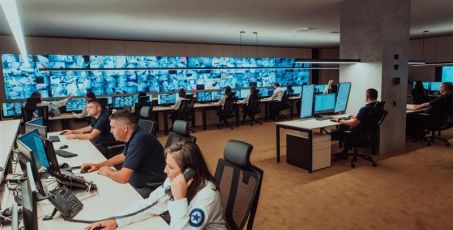The Future of Hybrid Meetings: Why as-a-Service is the Way Forward
14/11/25, 8:30 am
Introduction
Work has changed. The rigid nine-to-five office routine has given way to a new rhythm, defined by flexibility, mobility, and choice. Employees are splitting their time between home, the office, and other remote locations, while organisations are grappling with how to keep collaboration fluid, secure, and effective. Hybrid working is no longer an experiment; it is the new standard.
Yet while workforce behaviour has shifted, meeting rooms have often failed to keep pace. Many organisations still rely on ageing AV equipment, fragmented platforms, and ad hoc setups that frustrate users and drain IT resources. The question is no longer whether hybrid work will last, but rather: how can workplaces adapt their meeting environments to support it?
The meeting room problem
The promise of hybrid work is seamless collaboration, but the reality often looks very different. Employees report delays at the start of meetings due to patchy technology, poor-quality video undermines trust in remote interactions, and IT departments are bogged down responding to tickets about AV failures.
The numbers tell the story. Nearly 60% of Australian employees now work from home at least part of the week, and around half do so one to two days each week. But many workplaces still haven’t reconfigured their meeting rooms to meet the expectations of a hybrid workforce. The result is under-utilised spaces that drain resources without delivering value.
Why as-a-service is the answer
Traditional models of investing heavily in meeting room technology no longer make sense. A large capital outlay every few years, followed by slow refresh cycles, leaves organisations stuck with outdated equipment and rising maintenance costs.
By contrast, an as-a-service model like NEC’s Meeting Room as a Service (MRaaS) offers a new way forward. Instead of large upfront investments, organisations subscribe to collaboration rooms for a predictable monthly cost. That subscription covers everything, from design, deployment, support, monitoring, updates, and even lifecycle refresh.
The benefits are immediate:
- Predictable costs – No more surprise refresh projects or CapEx spikes.
- Evergreen technology – Rooms are continuously updated, staying aligned with the latest platforms.
- Reduced IT burden – Proactive monitoring and remote management free IT teams from constant firefighting.
- Consistency at scale – Every room, in every location, delivers the same intuitive experience.
The hybrid imperative
The stakes are high. Research suggests hybrid work could add $18 billion to the Australian economy over the next decade, with employers already reporting 40%+ improvements in employee well-being and productivity gains of up to 70% under hybrid models.
But to unlock those benefits, the infrastructure supporting hybrid work must be robust, secure, and user-friendly. Collaboration spaces cannot afford to be the weak link. Employees should be able to walk into any room, press a button, and connect instantly - whether to a colleague across the hall or a partner across the world. Anything less erodes the value of hybrid work.
Security and compliance matter more than ever
The rise of hybrid meetings has also magnified the importance of secure, compliant communications. From government agencies to financial institutions, sensitive conversations increasingly take place via video and shared content. Outdated AV setups, unmanaged endpoints, or unpatched systems represent unacceptable risks.
With an as-a-service model, meeting rooms are delivered under a certified managed services framework. NEC, for example, operates MRaaS within an ISO27001-certified environment, ensuring encryption, patch management, and compliance are built into the service from day one. This gives organisations the assurance that every meeting (internal or external) is conducted in line with strict security standards.
From technology to experience
At its core, MRaaS is not just about technology - it’s about experience. A room that works seamlessly every time reduces frustration, builds trust in hybrid work, and ensures employees can focus on outcomes instead of troubleshooting.
Organisations that adopt as-a-service meeting rooms report fewer meeting delays, faster decision-making, and higher adoption of hybrid practices. For IT leaders, it means the ability to redirect resources toward innovation instead of routine support. For executives, it means a workplace strategy that supports agility, resilience, and long-term productivity.
Looking ahead: the future of collaboration rooms
Meeting room technology is evolving rapidly. Trends for 2025 point to accelerating investment in AI, automation, and immersive collaboration tools. AI-driven features like real-time translation, intelligent framing, and smart noise suppression are already transforming how people connect. In the near future, immersive collaboration using AR/VR and advanced analytics will become mainstream.
An as-a-service model ensures organisations don’t get left behind. Instead of being locked into static technology, CRaaS customers can adopt new capabilities as they emerge, without costly upgrades or disruptive change programs. It’s a future-proof approach to collaboration.
Conclusion
Hybrid work is here to stay, but delivering on its promise requires more than flexible policies - it requires an infrastructure designed for seamless collaboration. By shifting from CapEx-heavy, fragmented AV setups to an as-a-service model, organisations gain secure, consistent, and future-ready collaboration rooms that simply work.
For employees, this means fewer delays, better experiences, and more productive interactions. For organisations, it means agility, predictable costs, and confidence that their collaboration environment is always up to date.
As-a-Service isn’t just the future of technology - it’s the future of work itself.
See how NEC Australia is helping organisations modernise meeting spaces and elevate hybrid collaboration.




